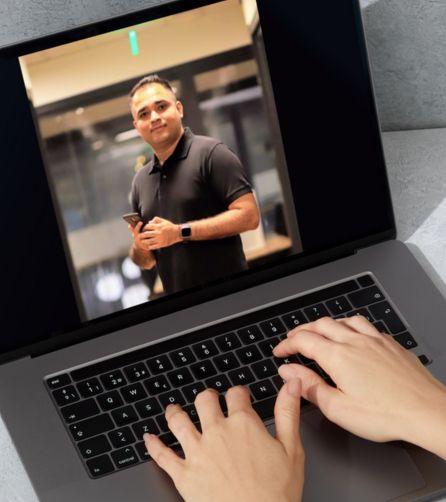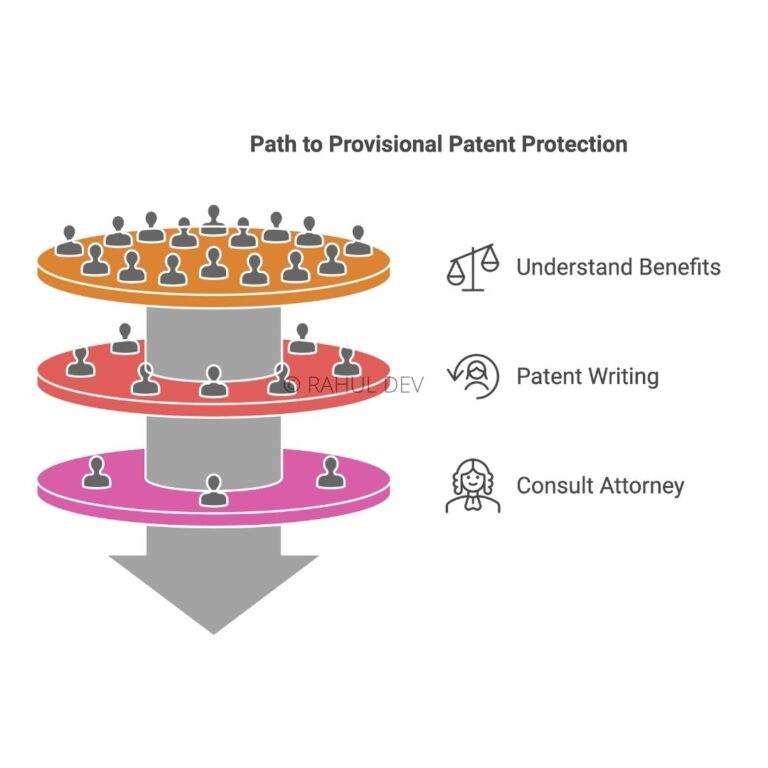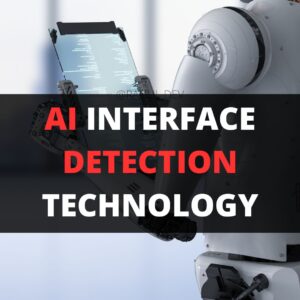AI Innovation Patents
Insights by Dr. Rahul Dev

Understand Practical Aspects
Understand the process of patenting AI inventions

Insights by Dr. Rahul Dev

Understand the process of patenting AI inventions

Protect your innovations across multiple countries and create strong patent portfolio to boost business valuation
Local and global brand protection through international trademark registrations
Extensive research and business writing for technical whitepapers and B2B content products
Here I write a complete guide about AI interface detection innovations and writing strong patents for AI interface detection technology. Artificial intelligence interface detection patents represent one of the fastest-growing segments in intellectual property today. The global patent landscape has witnessed an unprecedented surge, with 190,000 AI-related patents granted worldwide between 2000 and 2022. The USPTO alone issued 8,609 AI patents in 2024, marking a 21% increase from the previous year. This explosive growth reflects the critical importance of protecting AI innovations that revolutionize how we interact with digital interfaces.
Major technology companies recognize the strategic value of AI interface detection IP. IBM leads with 1,211 U.S. AI patents obtained in 2023, followed by Google and Microsoft who dominate Western AI patent portfolios. Companies like Amazon have secured valuable patents such as US11,221,833 for automated GUI object detection, while Automation Anywhere’s patent US11,886,892 for ML-based UI control detection demonstrates the commercial viability of these innovations.
This article covers following topics:
Contents of AI Interface Detection Patents
AI Interface Patents Landscape
Patentability Search for AI Interface Innovations
Writing Patent Claims for AI Interface Innovations


AI interface detection patents cover a diverse range of technologies that enable machines to perceive, understand, and interact with user interfaces. These patents typically cover three fundamental areas: computer vision algorithms for UI element recognition, machine learning models for interface behavior prediction, and automated systems for UI interaction and control. The core components protected in these AI patents include neural network architectures designed specifically for graphical user interface analysis. Companies patent convolutional neural networks (CNNs) that identify buttons, menus, text fields, and other UI elements from screenshots or live interface captures. Advanced patents cover transformer models that understand contextual relationships between interface elements, enabling more sophisticated automation.
Training methodologies represent another crucial patent category. Inventors protect novel approaches for generating synthetic training data, transfer learning techniques for adapting models across different applications, and reinforcement learning frameworks that improve through interaction with interfaces. These training innovations often provide the competitive edge that makes patents valuable. System integration patents protect the broader infrastructure required for AI interface detection. These include patents covering real-time processing pipelines, multi-modal input fusion combining visual and textual interface data, and feedback loops that enable continuous model improvement. The most valuable patents often combine multiple technical innovations into cohesive systems.
The AI interface patent landscape reveals fascinating geographic and technological patterns. China leads in sheer volume with 38,210 generative AI patent filings from 2014-2023, yet only 7% of Chinese AI patents have been filed overseas, indicating potential gaps in international coverage. Japan filed approximately 26,400 AI patent applications in 2024, ranking third globally after the U.S. and China. Tech Center 2100 at the USPTO handles the majority of AI interface patents, with 79% of AI-related applications ultimately receiving approval. This contrasts sharply with Tech Center 3600, which handles business methods and maintains notoriously low Section 101 allowance rates. Strategic applicants draft their inventions to ensure classification in Tech Center 2100 rather than the more restrictive business methods unit.
Market leaders demonstrate distinct patent strategies. Microsoft’s portfolio emphasizes security applications, including anomaly detection in post-authentication user behavior. Apple focuses on AR/VR interfaces with ML-based gesture recognition and adaptive UIs. Google’s patents concentrate on GUI testing automation and interface optimization algorithms. Amazon protects automated code generation from UI designs, creating valuable development tools. The AI patent landscape shows a 25-38% quarterly decline in AI patent filings as of late 2023, reflecting a strategic shift from quantity to quality. Companies now prioritize high-value patents with strong technical foundations rather than pursuing broad, potentially abstract applications that face rejection under Section 101.
Conducting a thorough patentability search for AI interface innovations requires systematic analysis across multiple patent databases and classification systems. The USPTO’s Artificial Intelligence Patent Dataset (AIPD) provides comprehensive coverage of U.S. AI patents from 1976-2023, allowing researchers to filter specifically for interface-related technologies.
Effective search strategies combine keyword analysis with classification code targeting. Relevant CPC codes include G06F3/048 for graphical user interface interaction techniques, G06F3/01 for human-computer interaction generally, and G06N20/00 for machine learning models. The intersection of these classifications (G06F3/048 & G06N20) pinpoints prior art on intelligent GUIs.
Commercial patent search tools like PatentSight and Derwent Innovation enable sophisticated landscape analysis. These platforms can generate visualizations showing patent clusters around RPA companies like UiPath and Automation Anywhere, AR/VR interface patents from Apple and Meta, and GUI testing automation from Google. Such analysis reveals white spaces where new innovations might achieve patent protection. International databases require parallel searching. EPO’s Espacenet covers European and global patents with advanced classification filters. WIPO’s Patentscope captures PCT applications, often the first international filing for AI innovations. China’s patent database reveals local innovations that may not appear in Western searches, providing complete competitive intelligence.
Search documentation should create matrices comparing prior art features against new inventions. Successful searches identify not just identical matches but also obviousness combinations where existing references might render new inventions unpatentable. This analysis guides claim drafting strategy and helps inventors understand exactly what innovations remain available for patent protection.
Writing patent claims for AI interface innovations demands careful attention to both technical accuracy and legal eligibility requirements. The USPTO’s July 2024 AI Guidance emphasizes that claims must describe “technical solutions to technical problems” rather than abstract algorithmic concepts. Successful claims integrate AI techniques with concrete technical improvements.
Independent claims should follow a structured approach: system components with specific hardware elements, AI processing steps that transform input data, and measurable technical outcomes. Amazon’s successful patent US11,221,833 exemplifies this structure by claiming specific steps for receiving UI design images, using computer vision to identify UI components with position coordinates, and generating executable code providing equivalent functionality.
Method claims require careful temporal sequencing. Effective claims recite obtaining interface data from specified sources, processing through defined AI models with particular architectures, and executing responsive actions on computing systems. Automation Anywhere’s patent US11,886,892 demonstrates this approach by claiming GUI image processing, filtering overlapping sub-control objects within specified pixel proximity, and correlating remaining elements into complete UI controls. The system claims provide additional protection by covering apparatus configurations. These claims typically recite processors configured to perform specified operations, memory storing executable instructions, and interfaces for receiving input and providing output. The key lies in avoiding purely functional claiming while maintaining sufficient breadth for meaningful protection. The dependent patent claims should add specific technical limitations that enhance non-obviousness. These might specify particular neural network architectures, training data characteristics, threshold values for decision-making, or integration with specific hardware components. Well-crafted dependent claims provide fallback positions if independent claims face rejection while capturing valuable technical variations.
Filing patents for AI interface innovations requires strategic timing and jurisdiction selection based on market priorities and technical considerations. The Patent Cooperation Treaty (PCT) provides an attractive option for AI inventions, allowing applicants to delay costs while covering approximately 153 countries with a single application filed within 30 months of priority. USPTO filing strategies focus on avoiding Section 101 rejections through careful application drafting. Successful applications emphasize technical improvements rather than abstract algorithmic concepts. The AI patent applications should include detailed technical specifications describing AI model architectures, training methodologies, and concrete system implementations that demonstrate practical utility.
Prosecution timeline management becomes critical given the complexity of AI patent examination. USPTO examination of AI patents typically requires 2-3 years, with potential delays if Section 101 issues arise. Applicants should prepare comprehensive responses addressing eligibility concerns by highlighting technical improvements and citing favorable precedents like Core Wireless v. LG Electronics.
The international patent filing strategies must account for different examination standards across jurisdictions. European Patent Office applications require explicit technical effect demonstration, often necessitating more detailed problem-solution statements than U.S. applications. Chinese applications benefit from emphasizing technical solutions using natural laws to solve concrete problems, aligning with CNIPA’s 2023 AI examination guidelines.
Continuation strategies enable iterative patent protection as AI technologies evolve. Successful applicants file continuation applications claiming new technical developments while maintaining priority dates. This approach builds comprehensive patent portfolios protecting multiple aspects of AI interface innovations over time.
Global patent protection for AI interface innovations demands understanding diverse legal frameworks and examination standards across major patent offices. The European Patent Office treats AI algorithms as mathematical methods, requiring technical applications producing tangible effects. Successful EPO applications frame AI interface detection as solving specific technical problems in GUI design or human-computer interaction. China’s Patent Examination Guidelines require AI inventions to constitute “technical solutions” utilizing natural laws. CNIPA’s 2023 updates provide detailed frameworks for AI patent applications, with interface detection inventions falling under AI applied to specific fields. Chinese examiners look for technical means and technical effects, making concrete system implementations essential for allowance.
Japan’s patent law requires inventions utilizing “laws of nature,” with the JPO publishing detailed AI examination case examples. Japanese applications succeed by demonstrating concrete technical implementations rather than abstract algorithmic concepts. The JPO’s case studies show that AI-based UI improvements for automobile dashboards or industrial machine interfaces typically achieve allowance due to their technical character. A cost-benefit analysis guides jurisdiction selection. U.S. patents provide broad market coverage for software companies but face Section 101 scrutiny. European patents offer strong enforcement across multiple countries but require technical effect demonstration. Chinese patents provide access to the world’s largest technology market with relatively lenient software patent standards when properly framed.
Patent Prosecution Highway (PPH) agreements between IP5 offices enable accelerated examination. Applicants receiving favorable examination results in one jurisdiction can expedite prosecution in partner countries, reducing overall timelines and costs. Strategic applicants leverage PPH to build international portfolios efficiently while maintaining consistent claim scope across jurisdictions. The AI interface detection patent landscape continues evolving rapidly as technology advances and legal frameworks adapt. Success requires combining technical innovation with strategic patent prosecution, creating valuable intellectual property portfolios that protect competitive advantages in this critical technology sector. Companies investing in comprehensive patent strategies position themselves advantageously in the accelerating AI revolution transforming human-computer interaction.

As a business coach and thought leader, I cannot emphasize enough the importance of innovation, new software patents, mobile apps, and patents for tech companies, startups, and entrepreneurs. The world is rapidly evolving, and staying ahead of the curve is vital for success. Embracing technological advancements such as blockchain and AI can unlock unprecedented opportunities, streamline operations, and propel businesses into the future with competitive valuation via intangible assets.
Click Here for AI Startup Valuation Guide.
For instance, blockchain technology can revolutionize supply chain management and secure data sharing wherein innovative business models are explained to the audience via technical whitepapers, while AI can automate and optimize decision-making processes. Mobile apps are no longer just a luxury; they have become essential tools for engaging customers and offering personalized experiences. Furthermore, securing digital innovation patents is crucial for protecting intellectual property, fostering innovation, and maintaining a competitive edge. By investing in these areas, businesses can position themselves as industry pioneers and pave the way for a prosperous future after thoroughly conducting the due diligence and reviewing the legal opinion letters, which in case of digital assets can assist in determining the tokens as utility assets or coins as utility tokens before listing the assets at an exchange.
Our team of advanced patent attorneys assists clients with patent searches, drafting patent applications, and patent (intellectual property) agreements, including licensing and non-disclosure agreements. Advocate Rahul Dev is a Patent Attorney & International Business Lawyer practicing Technology, Intellectual Property & Corporate Laws. He is reachable at rd (at) patentbusinesslawyer (dot) com & @rdpatentlawyer on Twitter.
Quoted in and contributed to 50+ national & international publications (Bloomberg, FirstPost, SwissInfo, Outlook Money, Yahoo News, Times of India, Economic Times, Business Standard, Quartz, Global Legal Post, International Bar Association, LawAsia, BioSpectrum Asia, Digital News Asia, e27, Leaders Speak, Entrepreneur India, VCCircle, AutoTech).
Regularly invited to speak at international & national platforms (conferences, TV channels, seminars, corporate trainings, government workshops) on technology, patents, business strategy, legal developments, leadership & management.
Working closely with patent attorneys along with international law firms with significant experience with lawyers in Asia Pacific providing services to clients in US and Europe. Flagship services include international patent and trademark filings, patent services in India and global patent consulting services.
Global Blockchain Lawyers (www.GlobalBlockchainLawyers.com) is a digital platform to discuss legal issues, latest technology and legal developments, and applicable laws in the dynamic field of Digital Currency, Blockchain, Bitcoin, Cryptocurrency and raising capital through the sale of tokens or coins (ICO or Initial Coin Offerings).
Blockchain ecosystem in India is evolving at a rapid pace and a proactive legal approach is required by blockchain lawyers in India to understand the complex nature of applicable laws and regulations.